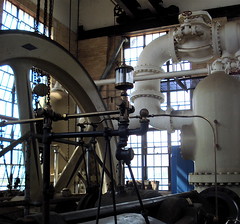The Industrial Revolution was a period from the 18th to the 19th century where major changes in agriculture, manufacturing, mining, transport, and technology had a profound effect on the socioeconomic and cultural conditions starting in the United Kingdom, then subsequently spreading throughout Europe, North America, and eventually the world.
The Industrial Revolution marks a major turning point in human history; almost every aspect of daily life was eventually influenced in some way.
Most notably, average income and population began to exhibit unprecedented sustained growth. In the two centuries following 1800, the world's average per capita income increased over 10-fold, while the world's population increased over 6-fold.[2] In the words of Nobel Prize winning Robert E. Lucas, Jr., "For the first time in history, the living standards of the masses of ordinary people have begun to undergo sustained growth. ... Nothing remotely like this economic behavior has happened before."[3]
Starting in the later part of the 18th century there began a transition in parts of Great Britain's previously manual labour and draft-animal–based economy towards machine-based manufacturing. It started with the mechanization of the textile industries, the development of iron-making techniques and the increased use of refined coal.[4] Trade expansion was enabled by the introduction of canals, improved roads and railways.[5]
The introduction of steam power fuelled primarily by coal, wider utilisation of water wheels and powered machinery (mainly in textile manufacturing) underpinned the dramatic increases in production capacity.[6] The development of all-metal machine tools in the first two decades of the 19th century facilitated the manufacture of more production machines for manufacturing in other industries.
The effects spread throughout Western Europe and North America during the 19th century, eventually affecting most of the world, a process that continues as industrialisation. The impact of this change on society was enormous.[7]
skip to main |
skip to sidebar
For students and parents who love education and exploration of the social sciences . . .
Search This Blog
Followers
Blog Archive
-
▼
2010
(346)
-
▼
November
(24)
- Reading and reporting about France in World Geo, p...
- Indie work: Make a Quiche Lorraine to be sampled b...
- One of man's most ancient sources of protein: esca...
- The French and advanced technology
- Western Europe / France / Monuments of Paris project
- Nature trail hike on the perimeter of the Magnet c...
- Weather permitting, classes will take an instructi...
- Learning the map of the UK via symbols
- The Yankee states and the Big Apple test / Trudeau
- Small group tutoring - Writer's Workshop on Thurs ...
- Indie essays on England
- Norton Commando 850 / British motorcycles
- England was part of the Roman Empire; they called ...
- Iron & steam: the Industrial Revolution began in E...
- The modern history of the United Kingdom, aka Grea...
- NE states & Manhattan test next class
- The Thames, the Tower Bridge and the Tower of Lond...
- Britain and neighbors, the Western European nations
- West Side Story / Puerto Rico: US Possession conne...
- NYC: the Erie Canal and the Broadway show, "Annie"
- What to know about NYC
- Historic Manhattan: the Chrysler Building, New York
- Choices available in Indie essays
- Map quizzes: the twelve Midwest states followed by...
-
▼
November
(24)

